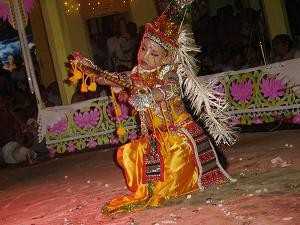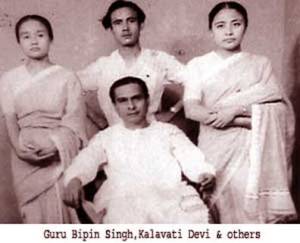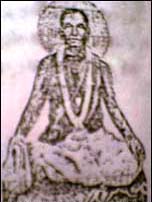
Gokulananda Gitiswami is a name deeply cherished by the Bishnupriya Manipuri people. There are practically few persons in the community who may not know his name. A versatile genius as well he was, he was a dramatist, a poet, a wandering minstrel and above all a social reformer. His life bears testimony to all these high qualities of head and heart which can be found only in few gifted persons.
Gokulananda was born on 26th November, 1886, at the Village of Madhabpur of Bhanugach ( in that time Bhanubil pargana) of Bangladesh. Gokuladanda could not prosecute his studies much, he could study only upto 8th standard because of some adverse circumstances, but his burning desire of acquiring knowledge remained with him which later on encouraged him to set up a school. He came over India later on and settled at Ratacherra village of Tripura. Here in 1925 he established a primary school by his own efforts to spread modern education among Bishnupriya Manipuris.
Unfortunately for us not much of his works are available. His compositions which survive today are remembered by the people from his popular refrains. Only a few years back Dr. K. P. Sinha and Haridas Sinha collected a few specimen of his writings. But the few lines which still survive, speak volumes about this great man who composed them
As stated earlier his was a multifaceted personality. A farsighted person as he was he could understand that the backwardness of the people of his community was due to lack of modern education. He, therefore, exhorted the Bishnupriya Manipuris to keep pace with the demands of time. A very conservative people as Bishnupriya Manipuris were at that time, most of the people did not go for modern education for fear of losing the purity of caste. To this was added the absence of schools which were in places few and far between. What the majority of Bishnupriya Manipuri boys studied at that time was Sanskrit grammar and poetics in the Tols (Sanskrit School) of that time. In fact there were quite a few learned Sanskrit scholars like Dhonai Pandit, Jagadananda Pandit, etc., to name just a few. Some boys went for learning the art of playing Mridangam, some for learning the art of Dohar dance and some for singing from their respective Gurus. In fact when I was a boy of 7/8 years some fifty years back my grandfather told me that one renowned Brahmin of his time, by seeing that in modern schools boys from all communities sit together and learn their lessons together expressed his apprehension that in future Bishnupriya Manipuris will not be able to preserve the purity of their caste if they study in such schools. Such was the state of affairs. Late Gokulananda was one of the few wise men who could foresee that without modern education there will be no progress of this community. He, therefore, sang –
Ruhi britti moutup karia dharia thaile nakortoi.
Satya Tretar ruhi hanou Kali Yuge nacholtoi.
Kale Kale Kalar Katha na-hunani nakarer
Jwigoi banhan puria anle kachai majai natharer.
Translation: “it will not serve any purpose if one clings to age old customs. The customs of Satya Yug and Treta Yug will not hold good in Kali Yug.”
One should not turn a deaf ear to the demands of time, because when fire starts burning the forests, it burns both dry and green timber at the same time.”
Gokulananda was a songstar i.e. Kirtania. In fact he earned his name and fame as a Kirtania. Hence, he was popularly known as Gokul Kirtanee also. But what made him tremendously popular among Bishnupriya Manipuri masses was that his songs in Bishnupriya Manipuri language in place of traditional Brajabuli had tenderness and mass appeal in them. Before him there were some persons like Leikhom Sena Sinha who tried to sing in Bishnupriya Manipuri language, but they did not gain that popularity. For the first time Gokulananda showed that tender emotions can be very well expressed in Bishnupriya Manipuri language as well.
This will be evident from the following lines of one of his “Basak Kirtan” —
Ar asha neyoil mungbara ngaloil
Singarei paril shataya
Translation: ‘There is no more hope, for the eastern sky is becoming bright and the bloomed singarei, i.e. Shefali flowers fall on the ground at day break’
The background of the lines is the following – When Srimati Radha was eagerly waiting for her beloved Sri Krishna by making a flower bed in a grove and when Sri Krishna did not turn up, in deep sorrow she said the above lines.
Gokulananda had set the tune of the song in such a way that when a person hears this song he will be deeply moved by the pathetic appeal of the song. He also composed many other songs for his dramas. He utilised his talents in propagating his ideas to Bishnupriya Manipuri masses. From young boys to the old, people used to gather enmasse to hear him. How much Gokulananda could influence the people has been well described by our renowned poet Madan Mohan Mukherjee. The effect of hearing Gokulananda is written by him in a poem as under:
Ak din para lengkora tor eta hunat giya
Kon herede mor punninghan torang katkoria
Khalkoruri torang jemon kita akta diya
Ailu ghore akkhutago onthokpahan oya.
Translation: “One day after going to hear the songs composed and sung by you, somehow I gave away my heart to you… I am thinking as if after giving something to you I came back alone somewhat bewildered.”
Because of all these qualities of a very high order, grateful people conferred on him the title “Geetiswami” along with a silver medallion, in a special session of Nikhil E3ishnupriya Manipuri Mahasabha, in 1935, which was done by none other than another great personality of the time namely Late Mahendra Kr. Sinha. From that time onwards he came to be known as “Geetiswami” also, which became very popular later on.
Late Geetiswami was an accomplished poet also. Apart from writing songs for his dramas, he used to write poetry also. One of his well known poem is “Matribandana” i.e. “Homage to mother”. The first two lines run as under:–
Ima, Ima tor mohima
Kita mattu sougo me.”
… … …
Imar sneha sindhu khudra eka bindu
Hujanir kaje bulia,
Deshe Deshe giya Imar gungan geya
Pagalgor Sade buluri.”
Translation: ” Oh mother, Oh mother, what can I say about your glories, I am but a child… to repay one small drop of mother’s ocean of love, I am wandering like wildman from place to place by singing mother’s glories.” So deep was his respect for his mother which has transcended from individual to universal appeal.
Late Gokulananda was like Bengal’s Charan Kabi Mukunda Das, a minstrel par excellence. He used to sing urging Bishnupriya Manipuri people to love their mother tongue and urged them to wake up from their slumber and face realities of life. He severely chastised the people for their self ego, while others derided at them. In pain he wrote –
“Nijor ghore nije raja
Miange dadi bulani”
Translation: you consider yourself to be a big person in your own residence, while other’s address you as dadi.” (Dadi” is a derogatory word used to address a Manipuri person)
He, therefore, exhorted the Bishnupriya Manipuri people to shake of their deep slumber and awake. He said —
“Ojnan adhararma ghumatai koti
Utha aji habihan jwaleya chei jnanor bati’.
Translation: How long, will you sleep in the darkness of ignorance. All of you must awake to-day. Look ahead after lighting the lamp of knowledge.’
Another salient point in his exhortations was that it was above communal bickering. He was traveling all around by singing such type of songs which infused social and linguistic awareness in the minds of Bishnurpriya Manipuri people.
Late Geetiswami was also a social reformer. He worked for the emancipation of women. He urged the Bishnupriya Manipuri women to walk with dignity. He severly criticised those who did not dress up properly. At that time Bishnupriya Manipuri women used to go to weekly markets to sell their home made products. Sometimes they were insulted by others, which hurt his feelings very much. He urged them to stop going to market. A seasoned campaigner as he was, he was greatly successful in preventing the womenfolk from going to market. But he had deep respect for women. He was pained by the way the women were treated at that time. He wrote —
“Jela eta ki bostukhan
har napeitarata,
Deshe Pandit neita?”
Translation: “People do not know how worthy women are. Are there no learned man in this land?”
At the same time he exhorted woman to realise their inner streangth. He, therefore, said
“Yuge Yuge cheita jelai jingechhita
Shaktite Bhabani, Bidyay Binapani,
Dhairyate Dharani, Bhaktite Braja Gopini,
Outar ongsha kala oya pahurlai nijor shakti.”
Translation: Oh mother, Oh mother, what can I say about your glories, I am but a child.In Yuga after Yuga women excelled. In strength it was Bhabani (Durga), in learning it was Binapani, in fortitude it was Mother Earth and in devotion the Gopikas of Brij. Being- part and parcel of them how you have forgeften your own strength?
One would not say such words unless he had deep regards for womankind. His was not always a path of roses. Revolutionary as his ideas were to the people of that time, he was more often than not misunderstood by the very people for whom he toiled. In anguish he wrote –
‘Kar kaje kadurita
Akgoyou har napeila,
Hobar kaje mattegate
Arak ahan ningkoila”.
Translation: “For whom am I crying? None tried to understood. What I said was for the good of them but they thought it to be otherwise.”
Later in his life Gokulananda joined the then undivided communist party of India in 1950 and he worked as an elected representative in the then Territorial Council of Tripura for a few years. In that capacity he served the local people.
This versatile great son of mother Bishnupriya Manipuri passed away on 10th July, 1962. His death spelt a pall of gloom in the minds of Bishnupriya Manipuri people. They were shocked to hear the news of his demise. The state of mind of the people is well expressed by one Krishnadas in a poem, few lines of which run as under –
‘Nirananda habihan
Amar samajhan
Gokulananda bihane Bishnupriya habi
Sharddhanjali nibedan
Kartara abedan
Gokulhin Samaj jatar ratiye.
Translation: All are grief stricken The whole of our society All Bishnupriya Manipuri in absence of Gokulananda. Offering their homage, Offering their prayers, Gokulless society is being engulfed by darkness of night.
Glowing tribute was paid by poet Bimal Kumar Sinha about his service to the society in the following lines –
“He girok Geetiswami tore homa diyar,
Tor deki manu ami napeitangai ar,
Buile ti gang ghorede ghum bhagil pou boya,
Chikkorle ghum bhagura manur alaya bouhan malaya,
Neyochhila age neyoitai pichhe sade manu tor,
Napeitoi Ima Bishnupriyai eshade seba jiputor.”
Translation: “Oh great Geetiswami! we bow to you, we will no more get a person like you
amongst us. You wandered from village to village by taking with you the message of awakening, you cooled the just awakened people by becoming the gentle breeze from the Malaya Mountain. There was none before, there will be none after like you. Mother Bishnupriya Manipuri will not get such a son’s service hereafter.”
Such were the feelings of the people at the time of death of Gokulananda Geetiswami. Bishnupriya Manipuri people have not forgotten the services rendered by him to the society. They observe his birth and death anniversaries through different organizations with the solemnity they deserve.
It is difficult to express in words the great service which Gokulananda Geetiswami rendered to the Bishnupriya Manipuri society. The development of Bishnupriya Manipuri language and literature owe a great deal to this great person. He is not only the founder of Bishnupriya Manipuri Identity – he proved himself to be our never-failing father, philosopher and guide.
ACKNOWLEDGEMENTS:
1. Fagu — 2nd year, 10th issue, October 1962.
2. Geetiswamir Ela — Edited by – Dr. K. P. Sinha, M.A., Pli. D.
3. Dils Lakshmindra Sinha — Mengsel, Oct.-Dec., 1992.
4. Nuwa Ela — 14th year, 6th issue, May-June, 1996.
5. Padya Kuru — By Bimal Kr. Sinha.
Contributed by Chandra Kanta Singha




 culture, both in Bangladesh and India. The impact of this great wandering social reformer Gokulananda on the Bisnupriya Manipuries has been manifold. He traversed the whole of Bishnupriya-speaking region – singing with a missionary fervour of the ills of our society and their remedies He devoted his entire life to the serve the community, to improve the condition of our people and to keep pace with the progress of other communities. He dramatized the plight of our women against the comparative indolence of men. He came under lot of turbulence of the times and he appeared to have wider sympathies. Because of all these qualities of a
culture, both in Bangladesh and India. The impact of this great wandering social reformer Gokulananda on the Bisnupriya Manipuries has been manifold. He traversed the whole of Bishnupriya-speaking region – singing with a missionary fervour of the ills of our society and their remedies He devoted his entire life to the serve the community, to improve the condition of our people and to keep pace with the progress of other communities. He dramatized the plight of our women against the comparative indolence of men. He came under lot of turbulence of the times and he appeared to have wider sympathies. Because of all these qualities of a very high order, grateful people conferred on him the title “Gitiswami” along with a silver medallion, in a special session of Nikhil Bishnupriya Manipuri Mahasabha, in 1935. On the other hand, Sri Bhubaneswar Sadhu Thakur was a popular spiritual master who born at Baropoa, now renamed Bhubaneshwar Nagar, in Cachar. He taught a moral code of love, forgiveness, charity, contentment, inner peace, devotion to God and Guru through his teachings and songs. He saved the people from spiritual degeneration owing to abject poverty. They have learnt from him to live honestly and peaceably with what little they have. He established the temple Sri Radha Gavinda Jew Mandir popularly known as “Govindabari” at Nabadwip in West Bengal which is a veritable abode of peace for the devotees.
very high order, grateful people conferred on him the title “Gitiswami” along with a silver medallion, in a special session of Nikhil Bishnupriya Manipuri Mahasabha, in 1935. On the other hand, Sri Bhubaneswar Sadhu Thakur was a popular spiritual master who born at Baropoa, now renamed Bhubaneshwar Nagar, in Cachar. He taught a moral code of love, forgiveness, charity, contentment, inner peace, devotion to God and Guru through his teachings and songs. He saved the people from spiritual degeneration owing to abject poverty. They have learnt from him to live honestly and peaceably with what little they have. He established the temple Sri Radha Gavinda Jew Mandir popularly known as “Govindabari” at Nabadwip in West Bengal which is a veritable abode of peace for the devotees. Senarik Singha Rajkumar from Cachar district of Assam are well known to Manipuri society as with them the new department of Manipuri Dance was created in the Shantiniketon (Calcutta) in the early 30’s. In 1921, the poet Rabindranath Tagore encountered Manipuri dancing in Sylhet district, a Bishnupriya Manipuri enclave (Machimpur) that is now part of Bangladesh. Tagore was fascinated with a Ras performance and he consequently invited these two Gurus. That was an epoch making events in the history of Manipuri Dance and within a decade in crossed its regional as well national fields and became a reputed international style.
Senarik Singha Rajkumar from Cachar district of Assam are well known to Manipuri society as with them the new department of Manipuri Dance was created in the Shantiniketon (Calcutta) in the early 30’s. In 1921, the poet Rabindranath Tagore encountered Manipuri dancing in Sylhet district, a Bishnupriya Manipuri enclave (Machimpur) that is now part of Bangladesh. Tagore was fascinated with a Ras performance and he consequently invited these two Gurus. That was an epoch making events in the history of Manipuri Dance and within a decade in crossed its regional as well national fields and became a reputed international style.
